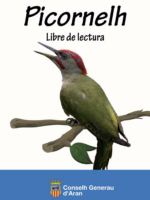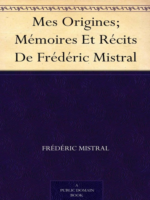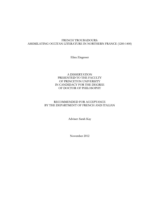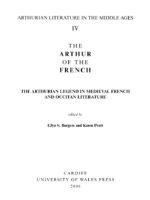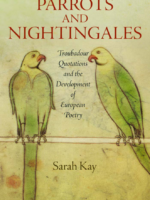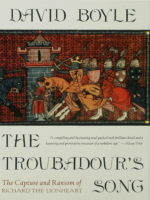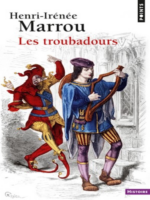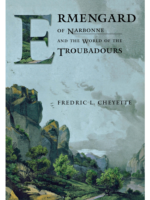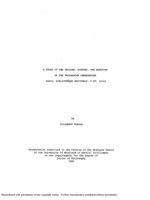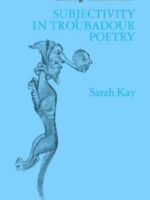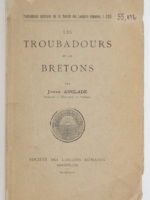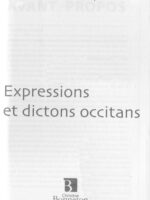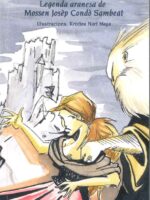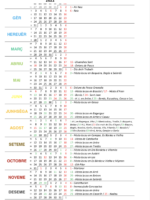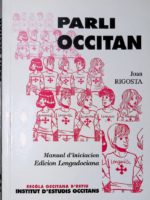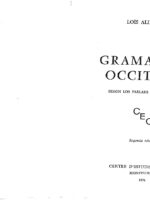Recommended Books
-
Picornelh
0,00 €Aguesta compilacion de trebalhs premiadi en Concors Literari Mossen Condò e en Concors de Diboish der an 2014, dempús de mès de quaranta ans d’auer començat a escríuer damb ua illusion enorma!
-
French troubadours: assimilating Occitan literature in northern France (1200-1400)
0,00 €French Troubadours explores the reception of Occitan lyric in France in the thirteenth and fourteenth centuries, that is, in the period corresponding to the Albigensian Crusade (1209–1229) and its aftermath, which witnessed France’s annexation of the majority of Occitania. Surveying the corpus of French romances that quote Occitan song (Part I) and French songbooks that also contain Occitan lyrics (Part II), it shows how Occitan poems–from the very beginning of their French reception–were subtly incorporated into the French canon by way of imitation, compilation with French texts, and adaptation to the French sound system.
Chapter 1, on Jean Renart’s Roman de la rose, shows how the troubadours are collapsed into a set of francophone lyrics, which are enjoyed not in France but by the Holy Roman Emperor. French-language lyric, and other forms of French culture, are presented as the degre zero of culture in the German Empire, while Germanic languages are treated as foreign. In Chapter 2, I turn to Gerbert de Montreuil’s Roman de la violette, which, like Renart’s Rose, appropriates troubadour lyrics linguistically, and–in one instance–also associates them with the Holy Roman Empire. Here, however, the Holy Roman Empire is not a neutral cadre, but a negative space. Chapter 3, devoted to Richard de Fournival’s Bestiaire d’amour, shows how Richard obscures the first-person language and rhyme of the troubadour poems he quotes.
In Part II, I turn to the set of French songbooks that transmit Occitan lyric. A study of compilation patterns reveals that, rather than being transmitted in a separate section of songbooks, Occitan poems–which are often Gallicized–are almost always interspersed with French lyrics. Consequently, a medieval reader who encountered the troubadours only in French transmission would have little chance of recognizing their cultural specificity. In Chapter 5, I explore the “pseudo-Occitan” corpus, which comprises pieces that contain Occitan phonological coloring but were probably composed by francophones. I show that these pieces occur primarily in a lower register. This trend fictionally repositions Occitan lyric as both “primitive” and–by extension–as anterior to French lyric.
-
The Arthur of the French: The Arthurian Legend in Medieval French and Occitan Literature
0,00 €This major reference work is the fourth volume in the series “Arthurian Literature in the Middle Ages”. Its intention is to update the French and Occitan chapters in R.S. Loomis’ “Arthurian Literature in the Middle Ages: A Collaborative History” (Oxford, 1959) and to provide a volume which will serve the needs of students and scholars of Arthurian literature. The principal focus is the production, dissemination and evolution of Arthurian material in French and Occitan from the twelfth to the fifteenth century. Beginning with a substantial overview of Arthurian manuscripts, the volume covers writing in both verse (Wace, the Tristan legend, Chretien de Troyes and the Grail Continuations, Marie de France and the anonymous lays, the lesser known romances) and prose (the Vulgate Cycle, the prose Tristan, the Post-Vulgate Roman du Graal, etc.).
-
Parrots and nightingales : troubadour quotations and the development of Europea poetra
0,00 €The love songs of Occitan troubadours inspired a rich body of courtly lyric by poets working in neighboring languages. For Sarah Kay, these poets were nightingales, composing verse that is recognizable yet original. But troubadour poetry also circulated across Europe in a form that is less well known but was more transformative. Writers outside Occitania quoted troubadour songs word for word in their original language, then commented upon these excerpts as linguistic or poetic examples, as guides to conduct, and even as sources of theological insight. If troubadours and their poetic imitators were nightingales, these quotation artists were parrots, and their practices of excerption and repetition brought about changes in poetic subjectivity that would deeply affect the European canon.
The first sustained study of the medieval tradition of troubadour quotation, Parrots and Nightingales examines texts produced along the arc of the northern Mediterranean—from Catalonia through southern France to northern Italy—through the thirteenth century and the first half of the fourteenth. Featuring extensive appendices of over a thousand troubadour passages that have been quoted or anthologized, Parrots and Nightingales traces how quotations influenced the works of grammarians, short story writers, biographers, encyclopedists, and not least, other poets including Dante and Petrarch. Kay explores the instability and fluidity of medieval textuality, revealing how the art of quotation affected the transmission of knowledge and transformed perceptions of desire from the “courtly love” of the Middle Ages to the more learned formulations that emerged in the Renaissance. Parrots and Nightingales deftly restores the medieval tradition of lyric quotation to visibility, persuasively arguing for its originality and influence as a literary strategy.
-
The Troubadour’s Song: The Capture and Ransom of Richard the Lionheart
0,00 €Chronicles the events surrounding the capture and release of King Richard I during the twelfth-century Third Crusade, describing the ransom delivered by Eleanor of Aquitaine that represented one quarter of England’s wealth and the subsequent legend that evolved about the singing troubadour, Blondel. By the author of The Sum of Our Discontent.
-
Les Troubadours
0,00 €Il serait temps de nous défaire enfin de ce poncif du troubadour errant, la guitare au côté, égayant de ses ballades les longs loisirs des tristes châteaux gothiques. C’est à cette image conventionnelle et fade que Henri-Irénée Marrou entend substituer la véritable identité et histoire des troubadours, en analysant plus généralement la “renaissance” du XIIe siècle.C’est à cette époque, en pays d’Oc, que les troubadours ont inventé l’amour, le mot comme la chose. C’est l’idéal quasi mystique de l’amour courtois qu’ils célèbrent dans leurs chansons, amour humain bien réel qui se trouve cependant presque élevé à la dignité d’un culte.La première édition de cet ouvrage date de 1961.Henri-Irénéee Marrou (1904-1977) est un des grands historiens de l’Antiquité tardive, spécialiste d’Augustin et de l’augustinisme ; a notamment publié au Seuil, L’Eglise de l’Antiquité tardive (1985) et Saint Augustin et l’augustinisme (2003).
-
Ermengard of Narbonne and the World of the Troubadours
0,00 €Ermengard of Narbonne. Even to specialists in the history of the Middle Ages her name is hardly known. Eleanor of Aquitaine, who was wife to two kings and the mother of three more? Yes, there is a name-and a story-to conjure with. Countess Marie of Champagne, Eleanor’s daughter by King Louis VII of France, patron of Chretien de Troyes, the poet who in- vented the Arthurian romance? She too is better known, if only because of the writers who thronged to her court. Ifwe know anything about the Middle Ages we have at least heard of King Richard the Lionheart and his brother King John, who was forced to grant the Magna Carta at Runnymede, both of them sons of Queen Eleanor. We have also surely heard of the mythical King Arthur and his Round Table, of Lancelot and Guinevere, of the quest for the Holy Grail, all of them largely the creation of Chretien. Ermengard, however, has fallen off the historical map.
-
A Study of the Origins, History, and Notation of the Troubadour
0,00 €The chansonnier Paris, Bibliotheque nationale, f. fr. 22543 (known as “R”) has been recognized for over 200 years as a precious repository of the literature of the medieval troubadours of southern France. It transmits almost 950 lyric poems and 160 melodies, along with many other important writings in the Occitan language, many of which are unica.
The paleography, decoration, and dialect of the manuscript are described thoroughly, and their distinctive features are seen to support the hypothesis that R was compiled in northern Languedoc or western Provence around 1300. While most of the texts of R were copied by one scribe, the relatively few melodies it contains were probably notated by at least four different copyists. Over eighty percent of the poems were never supplied with their melodies, even though musical staves were provided; these staves were left empty. The notation is in the style of the so-called Notre Dame school of Paris, and the rhythms of the notes are not apparent, although a few seem to be in rudimentary mensural notation.
The manuscript contains some works of the troubadours of the early twelfth century, and also a large number of works by late thirteenth-century poets. By examining internal paleographical data and making comparisons with other extant codices, it is possible to offer suggestions on the nature of the exemplars of this heterogeneous collection. The problems of determining how the texts and melodies were transmitted are investigated, including the issues of oral transmission, the lack of extant autographs, the disparity in the origins of the surviving manuscripts, and the variant attributions. The musical transmission is especially problematic, since only three other sources containing music survive. The forty-five concordances that R shares with these other codices are discussed.
A review of the modern history of the manuscript shows that the earliest known owner was the Marquise d’Urfe of the early eighteenth century. The commonly accepted belief that R was in the library of her ancestor the poet Honore d’Urfe in the seventeenth century is found to be unsupported by the available evidence.
-
Subjectivity in Troubadour Poetry
0,00 €The medieval troubadours of the South of France profoundly influenced European literature for many centuries. This book is the first full-length study of the first-person subject position adopted by many of them in its relation to language and society. Using modern theoretical approaches, Sarah Kay discusses to what extent this first person is a “self” or “character,” and how far it is self-determining. Kay draws on a wide range of troubadour texts, providing many close readings and translating all medieval quotations into English. Her book will be of interest both to scholars of medieval literature, and to anyone investigating subjectivity in lyric poetry.
-
Les troubadours et les Bretons
0,00 €Joseph Anglade siguec professor ena Universitat de Tolosa.
L’idée du présent travail date de plus de vingt-cinq ans..
-
Expressions et dictons occitans
0,00 €De A autant d’argent que de pesolhs à Virar coma un baciu fagord, ce sont plus de 1000 expressions et dictons occitans, enracinés au plus profond de notre quotidien, qui sont réunis et expliqués dans cet ouvrage. A leur source, l’observation et l’imagination pour les unes : Aimable coma una mosca d’ase ; Aver d’argent coma un chin de nièras ; Aver un cuol coma un amolaire ; Cargat coma un muol; Curios coma un pet ; Dormir coma una missara. la musicalité et la rime qui facilitent la mémorisation pour les autres : Al mes d’abriu, Io cocut canta, mort o viu ; Auba roja, vent o ploja ; Cada topin troba sa cabucèla ; Es lo matin que la jornada se pèrd o se ganha ; Grèc, pluèja al bec ; La raça raceja. Tous ont été choisis par l’auteur à partir d’enquêtes et de lectures personnelles.
-
Era Maladeta
0,00 €Vos presentam en aguest petit libre, magnificament illustrat per Kristina Nart Moga, ua legenda plan beròia recreada per Mn. Condò: Era Maladeta. Creiguem qu’ei plan interessant de hèr a conéishe aguest poèma, sustot entre es mès joeni, e tanben auem volut atau aumenatjar era figura de Mn. Condò, creador d’inspirades poesies ara lengua e ath país, e autor prolific d’òbres en toti es genres literaris qu’aué son un legat de gran valor tàs aranesi.
Blancaflor ei, coma comprovaratz damb era lectura, ua hemna valenta e d’esperit coratjós que sabec afrontr eth malur ath quau la sosmetec eth gigant Còrdehèr, en tot hèr dera aunestetat e dera solidaritat un cant ara sua libertat.
Esfòrç, coratge, volentat, amor, tolerància, solidaritat e aunestetat son vertuts de Blancaflor, coma ne son tanben de totes aqueres persones que luten per arténher, cadua des deth sòn petit mon, un país, eth nòste, mielhor en toti es aspèctes.

